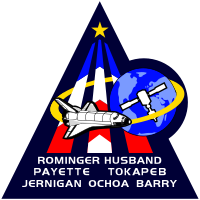STS-96
 | |
| Dane misji | |
| Indeks COSPAR | 1999-030A |
|---|---|
| Zaangażowani | |
| Oznaczenie kodowe | STS-96 |
| Pojazd | |
| Wahadłowiec | |
| Załoga | |
 Od lewej: Daniel Barry, Kent Rominger, Julie Payette, Ellen Ochoa, Walerij Tokariew, Rick Husband i Tamara Jernigan | |
| Dowódca | Kent V. Rominger |
| Start | |
| Miejsce startu | |
| Początek misji | |
| Orbita okołoziemska | |
| Apogeum | 340 km |
| Perygeum | 326 km |
| Okres orbitalny | 91,2 min |
| Inklinacja orbity | 51,6° |
| Lądowanie | |
| Miejsce lądowania | KSC, pas startowy 15 |
| Lądowanie | 6 czerwca 1999 06:02:43 UTC[1] |
| Czas trwania misji | 9 dni, 19 godzin, 13 minut i 1 sekunda[1] |
| Przebyta odległość | 6 mln km |
| Liczba okrążeń Ziemi | 154[1] |
| Program lotów wahadłowców | |
STS-96 (ang. Space Transportation System) – dwudziesta szósta misja wahadłowca Discovery i dziewięćdziesiąta czwarta programu lotów wahadłowców, która miała za cel dostarczenie zaopatrzenia do Międzynarodowej Stacji Kosmicznej[2].
Załoga
- źródło[2]
- Kent V. Rominger (4)*, dowódca
- Rick D. Husband (1), pilot
- Ellen Ochoa (3), specjalista misji 2
- Tamara „Tammy” Jernigan (5), specjalista misji 1
- Daniel Barry (2), specjalista misji 3
- Julie Payette (1), specjalista misji 4 (Kanada)
- Walerij Iwanowicz Tokariew (1), specjalista misji 5 (Rosja)
- *(w nawiasie podano liczbę lotów odbytych przez każdego z astronautów)
Parametry misji
- Masa:
- startowa orbitera: 118 859 kg
- lądującego orbitera: 100 230 kg
- ładunku: 9097 kg
- Perygeum: 326 km[3]
- Apogeum: 340 km[3]
- Inklinacja: 51,6°[3]
- Okres orbitalny: 91,2 min[3]
Dokowanie do ISS
- Połączenie z ISS: 29 maja 1999, 04:23:55 UTC
- Odłączenie od ISS: 3 czerwca 1999, 22:39:00 UTC
- Łączny czas dokowania: 5 dni, 18 godz., 15 min, 05 s
Cel misji
Drugi lot wahadłowca na stację kosmiczną ISS – misja zaopatrzeniowo-obsługowa z modułem Spacehab-LDM[2].
Spacer kosmiczny
EVA (30 maja 1999, 7 godz. 55 min): T. Jernigan, D. Barry[2].
Zobacz też
Przypisy
- ↑ a b c d Adam Chen, William Wallack, George Gonzales: Celebrating 30 Years of the Space Shuttle program. NASA, 2012. ISBN 978-0-16-090202-4.
- ↑ a b c d Tomáš Přibyl: Dzień, w którym nie wróciła COLUMBIA. Bielsko-Biała: Wydawnictwo >DEBIT<, 2003, s. 174. ISBN 83-7167-224-1.
- ↑ a b c d STS 96 (ang.). W: NSSDC Master Catalog [on-line]. NASA. [dostęp 2014-06-20]. [zarchiwizowane z tego adresu (2015-04-06)].
Linki zewnętrzne
- podsumowanie misji STS-96 na stronie KSC (ang.)
- Mark Wade: STS-96 (ang.). W: Encyclopedia Astronautica [on-line]. [dostęp 2017-07-25].
- Spaceflight mission report: STS-96 (ang.). Spacefacts. [dostęp 2017-07-25].
Media użyte na tej stronie
The flag of Navassa Island is simply the United States flag. It does not have a "local" flag or "unofficial" flag; it is an uninhabited island. The version with a profile view was based on Flags of the World and as a fictional design has no status warranting a place on any Wiki. It was made up by a random person with no connection to the island, it has never flown on the island, and it has never received any sort of recognition or validation by any authority. The person quoted on that page has no authority to bestow a flag, "unofficial" or otherwise, on the island.
Six NASA astronauts and a Russian cosmonaut take a break from training to pose for the STS-96 crew portrait. Astronaut Kent V. Rominger, mission commander, is at left on the front row. Astronaut Rick D. Husband, right, is pilot. The mission specialists are Ellen Ochoa (front center) and, from the left on the back row, Daniel T. Barry, Julie Payette, Valeriy I. Tokarev and Tamara Jernigan. Payette represents the Canadian Space Agency (CSA) and Tokarev is with the Russian Space Agency (RSA). The crew will perform the first station docking and will become the first visitors to the new International Space Station since its launch and start of orbital assembly last year. Discovery's launch date is now scheduled for May 20.
Designed by the crew members, this is the mission insignia for the STS-96 space flight, the second Space Shuttle mission dedicated to the assembly of the International Space Station (ISS). The crew patch highlights the major themes of the Station Program: Earth-directed research, the advancement of human space exploration, and international cooperation. The Space Shuttle Discovery is depicted shortly after reaching orbit as the crew prepares to carry out the first docking with the new Station. At this early stage in its construction, ISS consists of two modules: Zarya and Unity, shown orbiting Earth. The triangular shape of the patch represents building on the knowledge and experience of earlier missions, while the three vertical bars of the astronaut emblem point toward future human endeavors in space. The five-pointed star that tops the astronaut emblem in this depiction is symbolic of the five space agencies participating in the development of ISS: NASA, the Russian Space Agency, the European Space Agency, the National Space Development Agency of Japan, and the Canadian Space Agency. The blend of red, white, and blue is a tribute to the nationalities of the crew members who are from the United States, Canada, and Russia.




